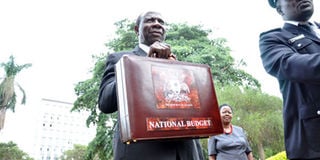Government to borrow Shs2.4 trillion to fund budget

External financing. Government is set to borrow Shs25 trillion to finance the budget. FILE PHOTO
What you need to know:
- Government has also cited non-receipt of World Bank budget support funds worth Shs375 billion and non-receipt of capital gains tax of Shs225 billion.
Government has presented to Parliament a request to borrow up to 600 million Euros (about Shs2.46 trillion) to fund deficits in the Budget for the current Financial Year 2019/2020.
The request was submitted during the House sitting yesterday, just five months into the financial year whose total budget estimates stand at Shs40.5 trillion.
The request made by Mr David Bahati, the Minister of State for Planning, indicates that Shs1.229 million (Euros 300 million) is to be obtained from Stanbic Bank Uganda while a similar amount is to be obtained from the Trade Development Bank (foreign).
The Trade and Development Bank, formerly the PTA Bank, is a trade and development financial institution in Africa and stands as the financial arm of the Common Market for Eastern and Southern Africa.
Mr Bahati justified the need for borrowing on “revenue shortfall and budget expenditure pressures.”
The minister also argued that with the target of Shs20.44 trillion from local revenue, government envisages Shs2.47 trillion shortfall, which will be fixed by borrowing.
Under Article 159 of the Constitution requires government to secure Parliament’s approval for every loan, including those intended to finance budget deficits.
Once obtained, government will have to service the loan within seven years at an interest rate of Shs217b (8.85 per cent) with Stanbic Bank charging 4.45 per cent and Trade Development Bank, 4.40 per cent. Government will be charged Shs79.9b as arrangement fees for the loan with Stanbic Bank and Trade Development Bank charging 1.75 per cent and 1.5 per cent of the loan sum respectively.
Government will also be given a grace period of two years from each bank.
In documents justifying the borrowing, Mr Bahati said government envisages a big shortfall worth Shs2.47 trillion in its budget for the current year.
Projected revenue
Government also cites budget pressures such as a projected revenue shortfall of Shs1.87 trillion yet there is additional expenditure requirements worth Shs1.43 trillion for classified expenditure (security).
The minister also said Shs11.22 trillion of the planned net local revenue (Shs20.08 trillion) has been released, leaving the next financial quarters with huge financial uncertainty.
By the end of June, Uganda’s public debt amounted to $12.43b (about Shs45.8 trillion) of which external and domestic debt accounted for $8.27b (Shs30.5 trillion) and $4.16b (about Shs15.3 trillion) respectively.
Government, however, insists its latest request to borrow will have no significant bearing on the gravity of the existing national debt and that the current debt level is still sustainable. The government’s latest request for additional borrowing has been referred to parliament’s Committee on National Economy for scrutiny with a report expected within 45 days.
Budget Constraints
Government has also cited non-receipt of World Bank budget support funds worth Shs375 billion and non-receipt of capital gains tax of Shs225 billion.
The resource envelope of Financial Year 2019/2020 totals Shs40.5 trillion of which tax and non-tax revenue amount to Shs20,895.6 billion.
Domestic financing was projected at Shs2.82 trillion, while external financing consists of project support of Shs9,433.6 billion and general budget support of Shs675.2 billion.
Mr Matia Kasaija, the Minister of Finance, in the Budget speech for this financial year, indicated that the budget deficit as a ratio of GDP is projected at 8.7 per cent compared to 5.8 per cent in the year ended June 30, 2019.
“This is a result of increased spending on infrastructure projects such as oil and tourism roads, the National Airline and power transmission lines,” Mr Kasaija said.
He added that the deficit would be “financed largely through external borrowing, and to a lesser extent through domestic borrowing.”



